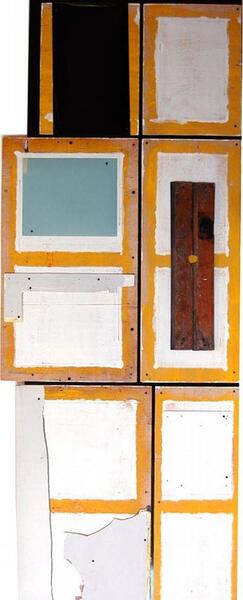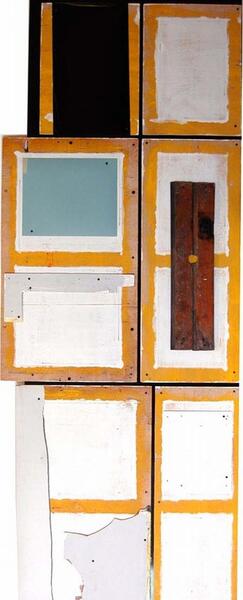_A Language beyond Form_
Alejandra Von Hartz, Miami
Taking the temporal and spatial axes as conducting thread, the exhibition A Language beyond Form (Un lenguaje más allá de la forma) constitutes a poetic incursion into our existential labyrinths, using the refined plastic forms of abstract and/or conceptual nature of ten Latin American leading artists as vital trigger.

The sense of delving into space (be it the plastic, the domestic or the communication space) is clearly reflected in the proposals of Danilo Dueñas, Eugenia Calvo and Horacio Zabala. Yellow Crate Wood, 2006, by Danilo Dueñas, presents a dismantled wooden crate, all the faces of which, displayed on the same plane – the gallery wall – generate an apparently suprematist composition. Interested in the constitutive qualities of the common materials and objects, Dueñas generates an interesting counterpoint between ordinary materials and their relationship with the art world.
In the case of the work by Eugenia Calvo, we are presented with an installation that shows a marked rhythmic accent. On the wall, fragments of everyday objects (broom sticks, table legs, etc.), recovered and associated because of their plastic quality, are distributed in sequence. The strong evocative power of the installation refers us to our daily life and specifically, to those unperceived moments which ultimately make up our existence. The laconic and forceful work of Horacio Zabala, Hipótesis XXXI (Hypothesis XXXI), on the other hand, is a reflection on silence. Part of the enigmatic series by the same name in which the artist deconstructs different symbolic systems which, once reconstructed, turn into inscrutable entities deprived of all significance, Hipótesis XXXI plays with extremely well known grammatical structures – in this case the full stop, as the conclusion of a void speech that seems to emphasize the pertinence of silence.
The series Color Theories, by Karina Peisajovich, also interested – like Zabala – in the analysis and deconstruction of communicative structures ̶ in this case, color ̶ is featured as a transition between one room and the other – an effective tunnel between space and time.
The series, rendered on the basis of tender strokes in colored pencils, reconstructs the history of the color systems developed from the days of ancient Greece and up to the 21st century. Particularly noteworthy among the theories revisited by Peisajovich are those by authors like Goethe, Munsell, Ostwald, Runge, Hering, Grosseteste, Mayer, Chevreul, and Young, among others. The result, delicate and of great beauty, constitutes a reflection on the artistic deed throughout time.
In the second room, the proposals by Soledad Arias, Leonora de Barros, Juan Pablo Garza, Teresa Pereda and Odalis Valdivieso, co-exist. Worthy of special mention are the proposals by Juan Pablo Garza and Teresa Pereda, both interested in time as a creative agent.
Capas de papel expuesto (Layers of exposed paper), 2012, by Garza, is the result of the inkjet application on cotton photographic paper which, successively folded and exposed to the passage of time, generates as a result a grid of varied hues. Cuando el agua calla (When Water is Silent), 2009, by Teresa Pereda, comprises drawings made by natural agents. Pereda immerses the paper in deposits excavated in the ground, allowing the passage of time assisted by the mud of the place, as well as the movement of the air with the water and other natural elements, to generate the resulting painting.
As a kind of counterpoint, Lenora Barros’ video focuses on the human eagerness to capture time. The work shows different clock hands which have been intervened in as a result of the wish to control Chronos, which inevitably leads to chaos.
-
 Yellow Crate - Wood, 2006. Wood of a Crate and Formica® on Formica®, 96 x 35 in./ Madera de guacal y Formica® sobre Formica®, 243,8 x 89 cm
Yellow Crate - Wood, 2006. Wood of a Crate and Formica® on Formica®, 96 x 35 in./ Madera de guacal y Formica® sobre Formica®, 243,8 x 89 cm




